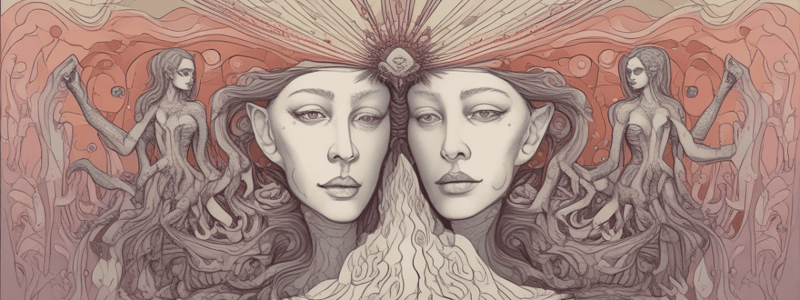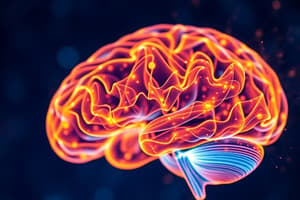Podcast
Questions and Answers
What is thought broadcasting in the context of schizophrenia?
What is thought broadcasting in the context of schizophrenia?
- The patient's thoughts escape into the outside world and are experienced by others. (correct)
- Audible thoughts, voices speaking the patient's thoughts aloud.
- Voices commenting on one's actions, describing the patient's activities as they occur.
- The patient's thoughts are being removed by an external force.
At what age does schizophrenia rarely present?
At what age does schizophrenia rarely present?
- After age 55 (correct)
- Before age 15
- After age 45
- Before age 10
What is the estimated heritability rate of schizophrenia?
What is the estimated heritability rate of schizophrenia?
- 60%-80% (correct)
- 50%-60%
- 40%-50%
- 80%-90%
What is the concordance rate among monozygotic twins for schizophrenia?
What is the concordance rate among monozygotic twins for schizophrenia?
What is the neurodevelopmental hypothesis based on?
What is the neurodevelopmental hypothesis based on?
What is the estimated lifetime prevalence of schizophrenia?
What is the estimated lifetime prevalence of schizophrenia?
What can cause psychosis, either in intoxication or withdrawal?
What can cause psychosis, either in intoxication or withdrawal?
What is a characteristic of schizophrenia?
What is a characteristic of schizophrenia?
What is the active phase of schizophrenia characterized by?
What is the active phase of schizophrenia characterized by?
What is a key feature that distinguishes substance-induced psychosis from schizophrenia?
What is a key feature that distinguishes substance-induced psychosis from schizophrenia?
What is the prodromal phase of schizophrenia characterized by?
What is the prodromal phase of schizophrenia characterized by?
What is the residual phase of schizophrenia characterized by?
What is the residual phase of schizophrenia characterized by?
What is the main difference between an illusion and a hallucination?
What is the main difference between an illusion and a hallucination?
What is the most common type of hallucination exhibited by schizophrenic patients?
What is the most common type of hallucination exhibited by schizophrenic patients?
What is the characteristic of circumstantiality in formal thought disorders?
What is the characteristic of circumstantiality in formal thought disorders?
What is the term for thoughts that are associated by the sound of words rather than their meaning?
What is the term for thoughts that are associated by the sound of words rather than their meaning?
What is the characteristic of flight of ideas in formal thought disorders?
What is the characteristic of flight of ideas in formal thought disorders?
What is the term for a breakdown in both the logical connection between ideas and the overall sense of goal directedness?
What is the term for a breakdown in both the logical connection between ideas and the overall sense of goal directedness?
Which of the following factors is associated with a worse prognosis in schizoaffective patients?
Which of the following factors is associated with a worse prognosis in schizoaffective patients?
What is the primary goal of medical therapy in schizoaffective patients?
What is the primary goal of medical therapy in schizoaffective patients?
What is the key distinguishing feature of Brief Psychotic Disorder compared to schizophrenia?
What is the key distinguishing feature of Brief Psychotic Disorder compared to schizophrenia?
What is the typical age range for the onset of Delusional Disorder?
What is the typical age range for the onset of Delusional Disorder?
What is the characteristic of delusions in Delusional Disorder?
What is the characteristic of delusions in Delusional Disorder?
What is the primary focus of treatment in Delusional Disorder?
What is the primary focus of treatment in Delusional Disorder?
What is the minimum duration of medication intake before efficacy is determined?
What is the minimum duration of medication intake before efficacy is determined?
Which of the following is a unique feature of clozapine?
Which of the following is a unique feature of clozapine?
Which second-generation antipsychotic is indicated for use in treatment-resistant depression when combined with fluoxetine?
Which second-generation antipsychotic is indicated for use in treatment-resistant depression when combined with fluoxetine?
What is the primary reason for reserving clozapine for patients who have failed multiple antipsychotic trials?
What is the primary reason for reserving clozapine for patients who have failed multiple antipsychotic trials?
What is the recommended course of action if a patient does not respond to clozapine by 6 months?
What is the recommended course of action if a patient does not respond to clozapine by 6 months?
Which of the following is NOT a therapeutic indication for second-generation antipsychotics?
Which of the following is NOT a therapeutic indication for second-generation antipsychotics?
Flashcards are hidden until you start studying
Study Notes
Perceptual Disturbances
- Illusion: misinterpretation of an existing sensory stimulus
- Hallucination: sensory perception without an actual external stimulus
- Types of hallucinations:
- Auditory: most common in schizophrenic patients
- Visual: less common in schizophrenia, may accompany drug intoxication, drug and alcohol withdrawal, or delirium
- Olfactory: usually an aura associated with epilepsy
- Tactile: usually secondary to drug use or alcohol withdrawal
Formal Thought Disorders
- Thought process differs from thought content in that it does not describe what the person is thinking, but rather how the thoughts are formulated, organized, and expressed
- Normal thought process: typically described as linear, organized, and goal-directed
- Abnormal thought processes:
- Circumstantiality: overinclusion of trivial or irrelevant details that impede the sense of getting to the point
- Tangentiality: in response to a question, the patient gives a reply that is appropriate to the general topic without actually answering the question
- Clang associations: thoughts are associated by the sound of words rather than by their meaning
- Derailment (loose associations): a breakdown in both the logical connection between ideas and the overall sense of goal-directedness
- Word salad: incoherent collection of words
- Flight of ideas: a succession of multiple associations so that thoughts seem to move abruptly from idea to idea
DSM-5 Criteria for Psychosis
- Hallucinations and/or delusions
- Symptoms do not occur only during an episode of delirium
- Evidence from history, physical, or lab data to support a medication or substance-induced cause
Schizophrenia
- Characterized by disturbances in cognition, emotion, perception, thinking, and behavior
- Probably comprises a group of disorders along a spectrum with heterogeneous etiologies and is characterized by:
- Disturbances in cognition, emotion, perception, thinking, and behavior
- Structural and functional abnormalities visible in neuroimaging studies
- Genetic component as seen in twin studies
- Classically, patients with schizophrenia are described as having:
- Poor insight into the nature and the severity of their disorder
- Lack of compliance with treatment
- The disorder is usually chronic, with a course encompassing:
- Prodromal phase: decline in functioning that precedes the first psychotic episode
- Active phase: perceptual disturbances, delusions, and disorganized thinking
- Residual phase: occurs following an episode of active psychosis
Symptoms of Schizophrenia
- Thought broadcasting: the patient's thoughts escape into the outside world and are experienced by others
- Thought withdrawal: the patient's thoughts are being removed by an external force
- Thought insertion: the patient's thoughts are being inserted by an external force
- Running commentary: voices commenting on one's actions
- Thought echo: audible thoughts, voices speaking the patient's thoughts aloud
- Third-person auditory hallucinations: voices arguing, the patient hears two or more voices, talking to each other, in their head
Epidemiology
- Schizophrenia affects approximately 0.5-1% of people over their lifetime
- Men and women are equally affected, but have different presentations and outcomes:
- Men tend to present in early to mid-20s, have more negative symptoms and poorer outcomes
- Women present in late 20s
- Schizophrenia rarely presents before age 15 or after age 55
- Strong genetic predisposition:
- 46% concordance rate among monozygotic twins
- 40% risk of inheritance if both parents have schizophrenia
- 12% risk if one first-degree relative is affected
Etiological Theories
- Genetic: genetic factors account for the majority of liability to schizophrenia, heritability estimates range from 60% to 80%
- Biologic:
- Neurochemical abnormality hypotheses:
- Dopaminergic overactivity
- Glutaminergic hypoactivity
- Serotonergic (5-HT) overactivity
- Alpha-adrenergic overactivity
- Gamma-aminobutyric acid hypoactivity
- Neurodevelopmental hypothesis:
- Excess of obstetric complications in those who develop the disorder
- Neurochemical abnormality hypotheses:
Prognosis
- Worse with poor premorbid adjustment, slow onset, early onset, predominance of psychotic symptoms, long course, and family history of schizophrenia
- Schizoaffective patients have a better prognosis than schizophrenic patients and a worse prognosis than mood disorder patients
Treatment
- Hospitalization (if necessary) and supportive psychotherapy
- Medical therapy: antipsychotics, mood stabilizers, antidepressants, or electroconvulsive therapy (ECT) may be indicated for treatment of mood symptoms
Brief Psychotic Disorder
- Diagnosis and DSM-5 Criteria:
- Patient with psychotic symptoms as in schizophrenia, but the symptoms last from 1 day to 1 month, and there must be an eventual full return to premorbid level of functioning
- Symptoms must not be due to the effects of a substance (drug or medication) or another medical condition
- Prognosis:
- By definition, the course of the disorder is less than 1 month
- Recovery is up to 80% with treatment
Delusional Disorder
- Disorder in which the primary or sole manifestation is a non-bizarre delusion that is fixed and unshakable
- Delusions are usually about situations that can occur and are possible in real life
- Delusional disorder occurs more often in middle-aged or older patients (after age 40)
- Delusions last at least 1 month and are well-systematized and non-bizarre as opposed to fragmented and bizarre
- The patient's emotional response to the delusional system is congruent with and appropriate to the content of the delusion
- The personality remains intact or deteriorates minimally
Studying That Suits You
Use AI to generate personalized quizzes and flashcards to suit your learning preferences.




